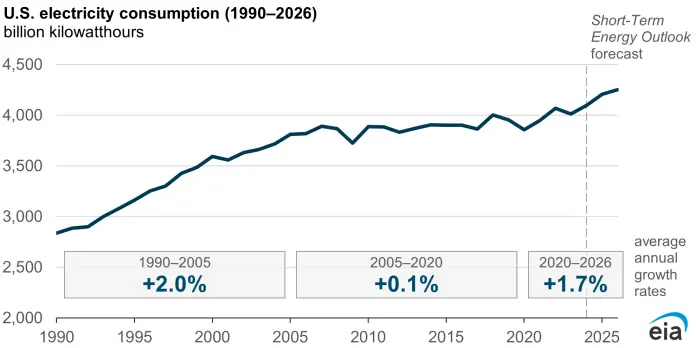U.S. Electricity Consumption Expected to Rise Significantly Over Next Two Years
In a notable shift from recent trends, U.S. electricity consumption is projected to surge in 2025 and 2026, reaching levels beyond the record highs seen in 2024. According to the latest Short-Term Energy Outlook released by the U.S. Energy Information Administration (EIA), this increase marks a significant change from nearly two decades of stagnant demand, particularly in the commercial and industrial sectors.
Small business owners, especially those in the commercial sector, should take note of this upward trend. With electricity demand heavily driven by commercial entities—including data centers and manufacturing establishments—the implications for small businesses are profound.
Electricity consumption remained largely flat from the mid-2000s to early 2020s, influenced by efficiency improvements and a shift towards less energy-intensive service industries. However, demand has revived since reaching a low in 2020. The EIA forecasts an average growth rate of 1.7% per year in electricity consumption from 2020 to 2026, with the commercial sector expected to grow even faster at 2.6%.
"Much of the recent and forecasted growth in electricity consumption is coming from the commercial sector," stated Mark Schipper, a principal contributor to the report. “This indicates that businesses are ramping up their operations, and with that comes increased energy needs.”
As demand increases, small business owners might need to consider the implications for both their immediate operations and long-term planning. Coupled with the influx of new generating capacity largely sourced from renewable energy sources such as solar and battery storage, the landscape of energy consumption is evolving.
The push for additional electricity capacity is concentrated in key regions, particularly Texas, California, the upper Midwest, and the Northeast. This regional growth can present opportunities for small businesses in these areas to take advantage of new energy offerings and potentially lower rates.
Utilities and grid operators are responding to this demand growth by investing in energy efficiency and demand-response programs. This means that as a small business owner, participating in such programs could lead to cost savings. Many utilities offer incentives for businesses that reduce their energy usage during peak demand times, which could ultimately help you save on your electric bill.
However, navigating these changes isn’t without its challenges. The anticipated rise in electricity costs could pressure margins for small businesses already grappling with tight budgets. Moreover, as electric utilities enhance their infrastructure—such as expanding high-voltage transmission lines to ensure reliable service—businesses may need to ensure their own energy strategies align with these developments.
"It’s crucial for small business owners to assess their energy use and explore efficiency measures," emphasized Tyler Hodge, another contributor to the report. “Understanding your business’s energy consumption patterns now will be beneficial as we see these changes unfold.”
While residential electricity sales are expected to grow at a modest rate of 0.7% annually between 2020 and 2026, the commercial and industrial growth rates suggest a clear opportunity for small business owners to innovate and expand. By understanding the forecasted demand, they can better position their operations to align with market trends.
As the EIA predicts robust growth in electricity consumption, small business owners should remain informed and proactive. Embracing energy-efficient technologies, exploring renewable energy options, and remaining adaptable to changing regulations and incentives could offer critical advantages in a shifting energy landscape.
For detailed insights, check the full report from the EIA here.
Image Via US Energy



